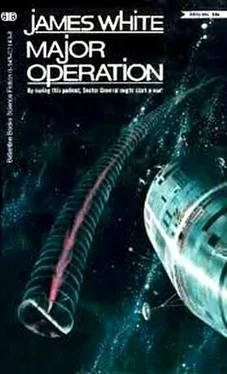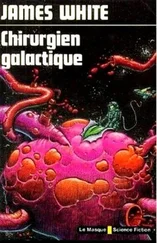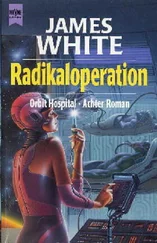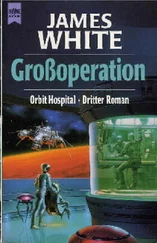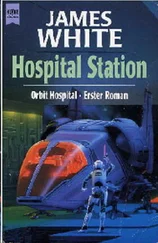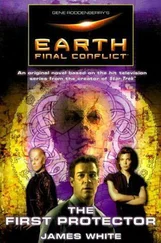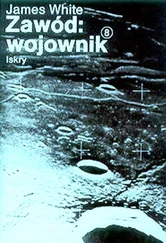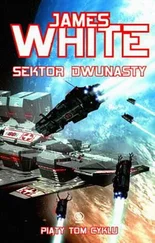Next day the framework was completed and work started on fitting the metal band which would take the temporary airlock. While the lock structure was going up Conway and Harrison attached safety lines to the framework and examined the hull. The Lieutenant discovered quite a lot about the steering jets and the circuits to the retro pack, while Conway could only stare baffled at the long, narrow exit hatch or stare through the tiny glass port-it was only a few inches in diameter-which showed little more than a shutter which opened and closed rapidly. And it was not until the following day that the Lieutenant and himself were able to enter the alien spacecraft.
Its occupant was still alive, Prilicla said, but only just.
As expected the waist section of the spacecraft was almost empty of water. Centrifugal force had caused it to collect toward the extremities of the ship, but their spotlights reflected off a dazzling fog of water vapor and droplets which, a quick investigation showed, were being stirred up by the operation of a system of sprocket wheels and chain drives that ran the length of the ship.
Moving carefully so as not to snag a hand between a gear wheel and its chain or inadvertently stick a boot through the fragile hull into space, the Lieutenant moved aft while Conway went forward. They did this so as to ensure that the vessel’s center of gravity stayed as closely as possible to its center of rotation, for any imbalance introduced now would shake loose the framework and probably tear holes in the sides of the ship.
“I realize that the circulation and purification of water requires heavier hardware than an air recycling system,” said Conway, speaking to Harrison and the tender, “but surely there should be a higher proportion of electrical to mechanical systems? I can’t move more than a few yards forward and all I can see are gear wheels and chains drives. The circulation system sets up a strong current, as well, and I’m in danger of being drawn into the works.”
The fine, ever-present mist of bubbles made it difficult to see clearly, but for a moment he caught a glimpse of something which was not part of the machinery-something that was brown and convoluted and with a suggestion of fronds or short tentacles sprouting from it, something organic. The being was hemmed in on all sides by revolving machinery, and it also seemed to be rotating, but there was so little of its body visible that he could not be sure.
“I see it,” said Conway. “Not enough for accurate classification, though. It doesn’t seem to be wearing a pressure suit so this must be its equivalent of shirt-sleeve conditions. But we can’t get at the brute without tearing its ship apart and killing it in the process.” He swore, then went on furiously, “This is ridiculous, insane! I’m supposed to come out here, immobilize the patient, transfer it to a ward and give treatment. But this blasted thing can’t be immobilized without …
“Suppose there is something wrong with its life-support system,” the Lieutenant broke in. “Something which requires gravity, or artificial gravity in the form of centrifugal force, to restore proper function. If we could somehow repair this malfunctioning equipment …
“But why?” said Conway suddenly, as a vague idea that had been lurking at the back of his mind began to creep out into the light. “I mean, why should we assume that it is malfunctioning …” He paused, then said, “We’ll open the valves of a couple of oxygen tanks in here to freshen up the beastie’s air — I mean water. It’s only a first-aid measure, I’m afraid, until we’re in a position to do something more positive. Then back to the tender, I’m beginning to get some odd ideas about this astronaut and I’d like to test them.”
They returned to the control room without taking off their suits, and were met by Prilicla who told them that the patient’s condition seemed a little better although it was still unconscious. The empath added that the reason for this might be that the being was injured and in an advanced state of malnutrition as well as having been close to death through asphyxiation. Conway began telling them about his idea and sketching the alien ship as he talked.
“If this is the center of spin,” he said when the drawing was complete, “and the distance from that point to the pilot’s position is this, and the rate of rotation is this, can you tell me how closely does the apparent gravity in the pilot’s position approach that of Meatball itself?”
“Just a minute,” said Harrison as he took Conway’s pen and began to scribble. A few minutes later-he had taken extra time to double check his calculations-he said, “Very close, Doctor. Identical, in fact.”
“Which means,” said Conway thoughtfully, “that we have here a beastie which can’t, for some very good physiological reason no doubt, live without gravity, for whom weightless conditions are fatal …
“Excuse me, Doctor,” the quiet voice of the radioman cut in. “I have Major O’Mara for you on Screen Two …
Conway felt the idea which was beginning to take shape at the back of his mind being blown into tatters. Spin, he thought furiously, trying to draw it back; centrifugal force, wheels within wheels! But the square, craggy features of the Chief Psychologist were filling the screen and it was impossible to think of anything else.
O’Mara spoke pleasantly-a very bad sign. He said, “Your recent activity has been impressive, Doctor-especially when it took the form of man-made meteorite activity in the shape of dropped tools and structural material. But I’m concerned about your patient. We all are-even, and especially, the Captain of Descartes who has recently returned to Meatball.
“The Captain has run into trouble,” the psychologist continued, “in the shape of three missiles with nuclear warheads which were directed at his ship. One of them went off course and dirtied up a large area of Meatball ocean, and the other two came so close that he had to use full emergency thrust to avoid them. He says that establishing communications and friendly contact with the inhabitants in these circumstances is impossible, that they obviously think he has kidnapped their astronaut for some ghastly purpose of his own, and that the return of the being in a happy and healthy condition is the only means there is of retrieving the situation … Doctor Conway, your mouth is open. Either say something or close it!”
“Sorry, sir,” said Conway absently. “I was thinking. There is something I would like to try, and perhaps you could help me with it — by getting Colonel Skempton’s support, I mean. We’re wasting time out here, I realize that now, and I want to bring the spacecraft inside the hospital. Still spinning, of course — at first, anyway. Cargo Lock Thirty is big enough to take it and is close enough to the water-filled corridor leading to the ward we are preparing for this patient. But I’m afraid the Colonel will be a bit sticky about allowing the spacecraft into the hospital.”
The Colonel was very sticky indeed, despite Conway’s arguments and the support given by O’Mara. Skempton, for the third time, gave a firm and unequivocal negative.
He said, “I realize the urgency of this matter. I fully appreciate its importance to our future hopes of trading with Meatball and I sympathize with your technical problems. But you are not, repeat not, going to bring a chemically powered spacecraft with a live retro pack inside this hospital! If it accidentally ignited we might have a hole blown in the hull which would cause a lethal pressure drop on a dozen levels, or the vehicle might go bulleting into the central computer or gravity-control sections!”
“Excuse me,” said Conway angrily, and turned to the Lieutenant. He asked, “Can you ignite that retro pack, working from the ambulance ship, or disconnect it?”
Читать дальше
